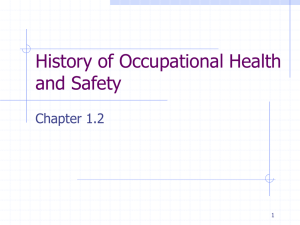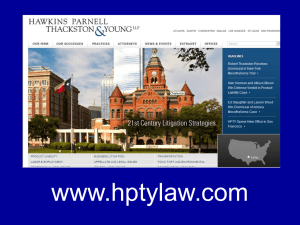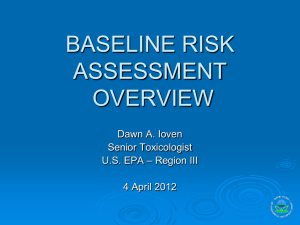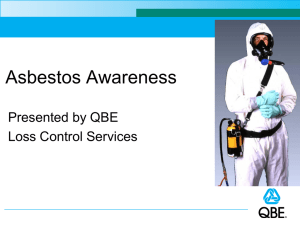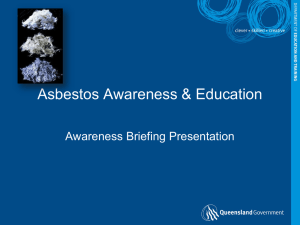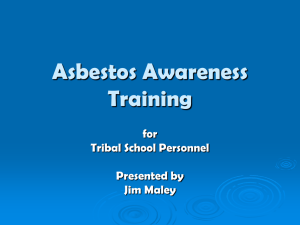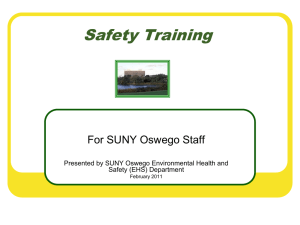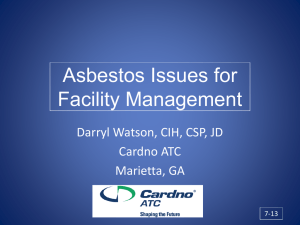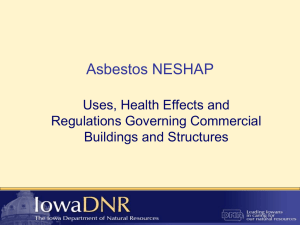Asbestos Awareness
advertisement
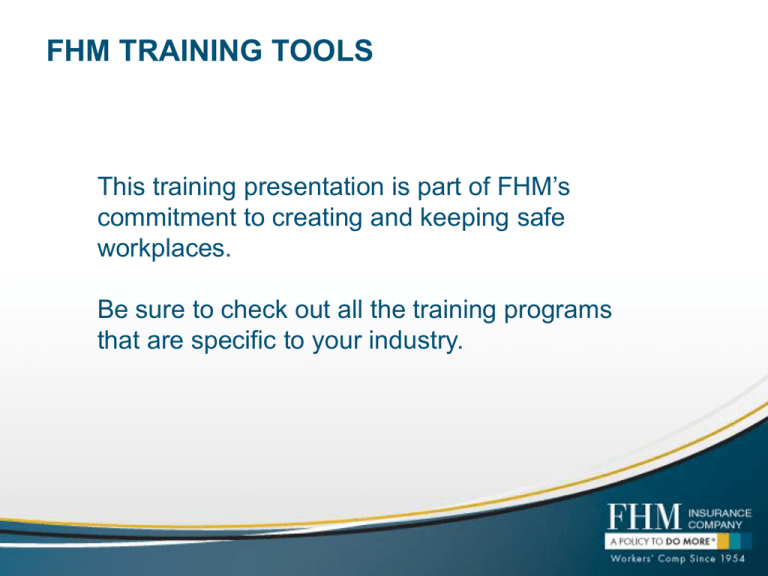
FHM TRAINING TOOLS This training presentation is part of FHM’s commitment to creating and keeping safe workplaces. Be sure to check out all the training programs that are specific to your industry. Asbestos Awareness ►►► These materials have been developed based on applicable federal laws and regulations in place at the time the materials were created. The program is being provided for educational and informational purposes only and does not constitute and is not intended to provide OSHA compliance certification, regulatory compliance, a substitute for any "hands on“ training required by applicable laws and regulations, or other legal or professional advice or services. By accessing the materials, you assume all responsibility and risk arising from the use of the content contained therein. ©2010 Grainger Safety Services, Inc. Learning Objectives At the conclusion of this presentation, you will: ► Understand the hazard communication information required by the OSHA General Industry Standard for Asbestos ► Recognize ► Be the uses and hazards of asbestos able to outline the basic elements of an Asbestos Management Plan Agenda Presentation Agenda: ► Background ► Hazards Information on Asbestos of Asbestos ► Asbestos Management Program Section 1 Overview What is Asbestos? Asbestos is a naturally occurring material: ► Most common forms – Amosite – Chrysotile – Crocidolite The “Miracle Mineral” Asbestos: ► Derived ► Called ► Large from the Greek word for “inextinguishable” the “Miracle Mineral” deposits were discovered in Canada History of Asbestos Unique properties: ► Fire retardant ► High tensile strength ► Poor heat and electric conductor ► Impervious to chemical attack Use of Asbestos Asbestos-containing materials: ► Insulation ► Ceiling ► Caulks, and floor tiles cements ► Shingles, ► Brake siding linings Asbestos Regulations Regulations: ► OSHA ► EPA ► DOT ► States Section 2 Hazards Asbestos Health Hazards Three primary diseases associated with asbestos exposure: ► Asbestosis ► Lung cancer ► Mesothelioma Asbestosis Exposure to asbestosis has caused: ► Serious, chronic, non-cancerous respiratory disease ► Inhaled fibers aggravate and scars lung tissues ► Symptoms include – Shortness of breath – Dry crackling sound when inhaling Lung Cancer and Asbestos Workers Lung cancer: ► Exposure to other carcinogens increase risk of lung cancer ► Smokers are more likely to develop lung cancer ► Symptoms include coughing and changes in breathing Mesothelioma Mesothelioma: ► Occurs ► Linked in the lungs, chest, abdomen, and heart with asbestos exposure ► Workers exposed to asbestos have increased risk Risk Factors Three main risk factors: ► Amount of exposure ► Smoking ► Age Section 3 Asbestos Management Program Identification Identification: ► Requirements ► “Presumed for facility and building owners Asbestos-Containing Materials” ► Microscopes are used to identify asbestos content Labeling Labeling: ► Label all materials containing asbestos ► Labels must be clearly visible ► Signs must designate airborne asbestos exceeding permissible levels ► Identify mechanical rooms where asbestos is present Housekeeping The asbestos management plan: ► Establishes procedures for working on or near installed asbestos ► Sanding ► Wet floor tile stripping ► Broken ceiling or floor tiles Fiber Release Episodes Fiber release episodes: ► Unplanned ► Procedures ► Can damage to asbestos-containing material must be developed for these events be handled internally or through contractor Do’s and Don’ts DO’s: ► Know where these materials are located ► Adhere to posted signs and labels DON’Ts: ► Disturb these materials ► Handle suspect materials Section 4 Your Responsibilities Your Responsibilities Your responsibilities: ► Know locations of asbestos-containing materials ► Adhere ► Only to all posted signs and labels enter regulated areas if trained and authorized Your Responsibilities Your responsibilities: ► Do not disturb asbestos-containing materials ► Do not handle any suspect materials ► Report any fiber release episode to management Additional Information Sources of additional information: Asbestos Standard for General Industry. OSHA Publication 3095, (1995). Asbestos: Criteria for a Recommended Standard. US Department of Health and Human Services (DHHS), National Institute for Occupational Safety and Health (NIOSH), (1976, December). The company’s Asbestos Management Plan





